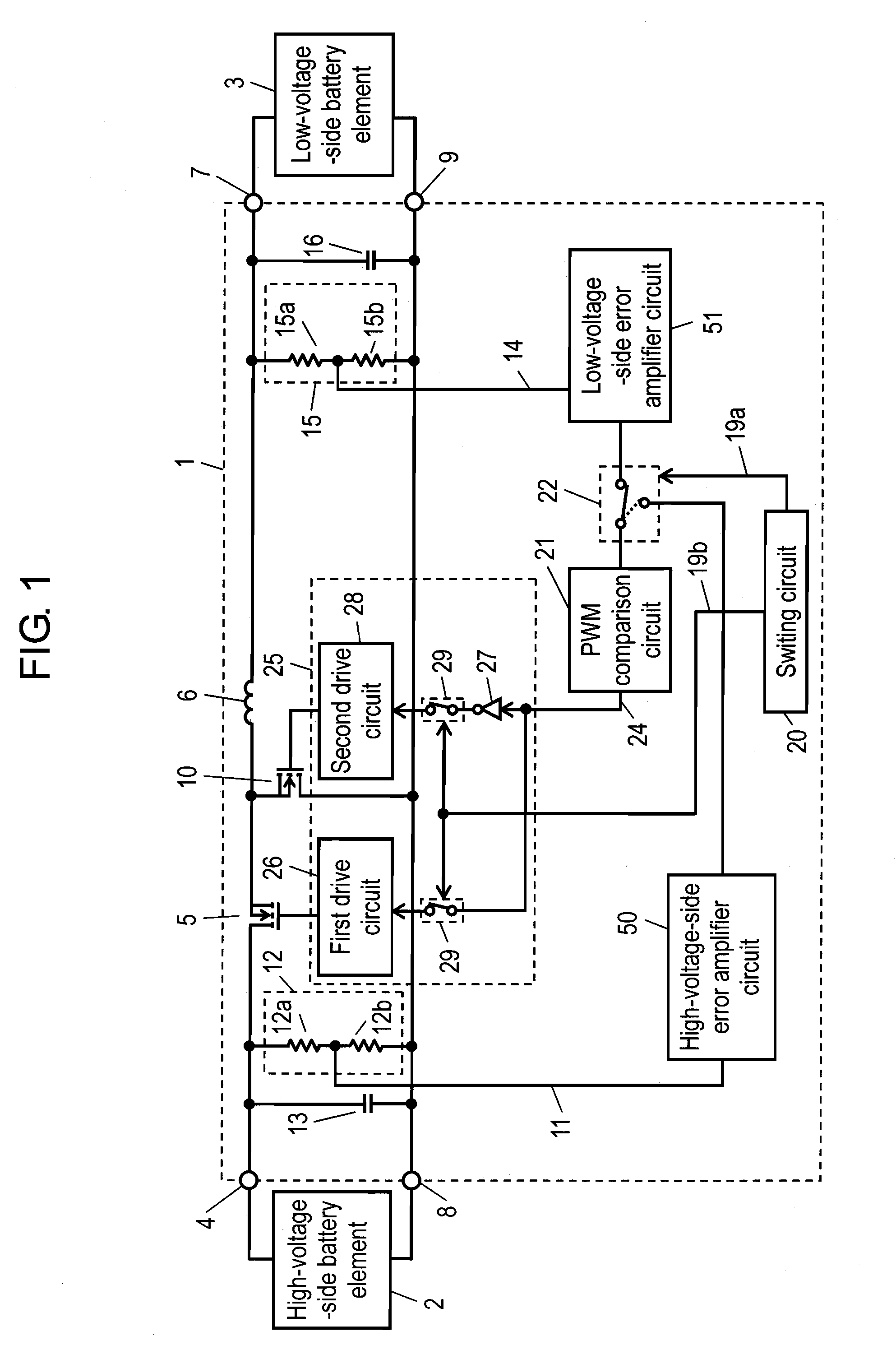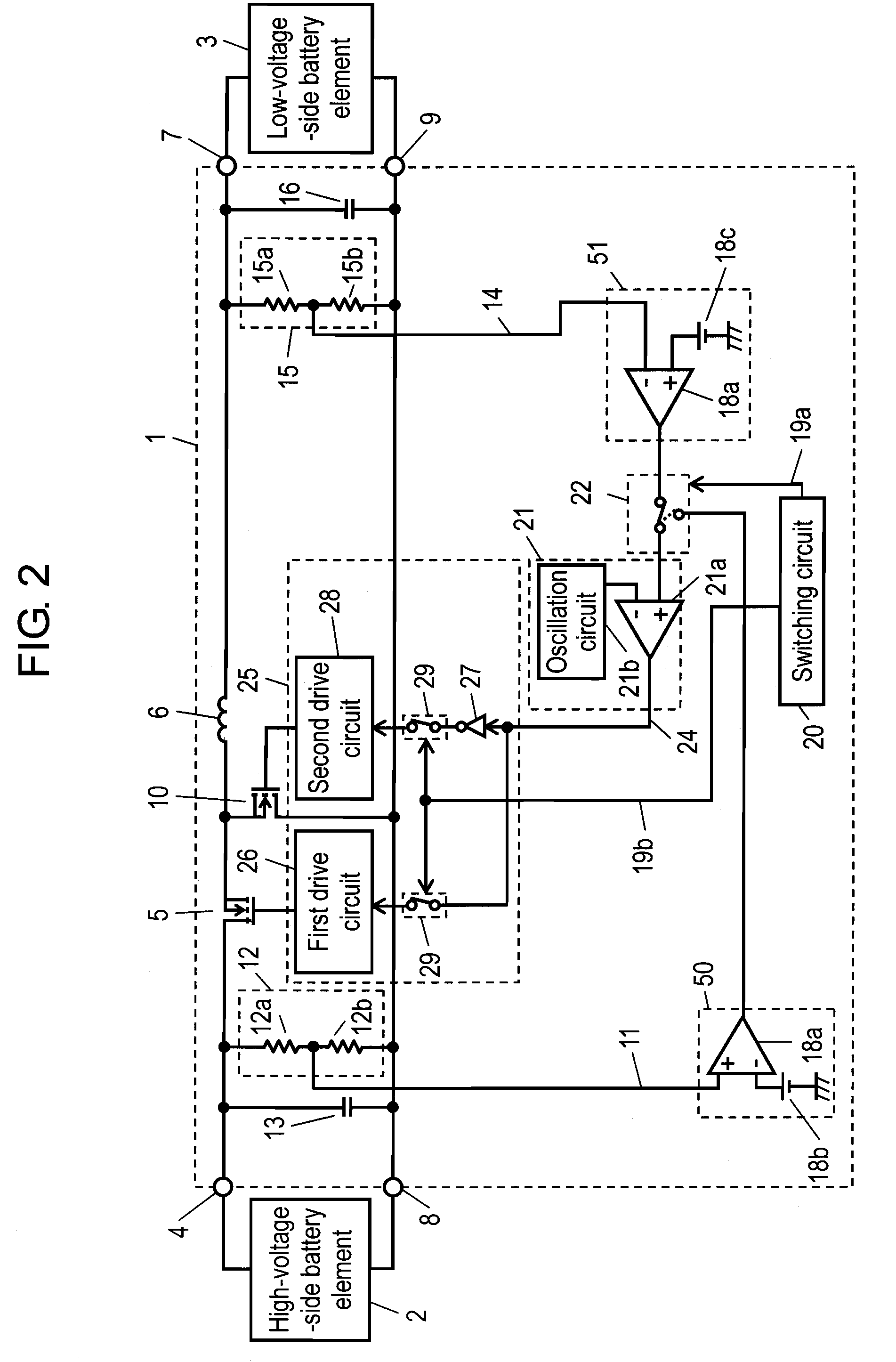Bidirectional dc-dc converter
a dc-dc converter and bi-directional technology, applied in the direction of dc-dc conversion, power conversion systems, instruments, etc., can solve the problems of complicated circuit configuration, double circuit configuration, complicated circuit configuration, etc., and achieve simple circuit configuration, increase the number of voltage error amplifier circuits, and simplify circuit configuration
- Summary
- Abstract
- Description
- Claims
- Application Information
AI Technical Summary
Benefits of technology
Problems solved by technology
Method used
Image
Examples
embodiment 1
Preferred Embodiment 1
[0123]In the preferred embodiment 1, a case of constant voltage output control is disclosed. FIG. 1 is a block circuit diagram of a bi-directional DC-DC converter in the preferred embodiment 1 of the present invention. FIG. 2 is a partially detailed block circuit diagram of a bi-directional DC-DC converter in the preferred embodiment 1 of the present invention. In FIG. 1 and FIG. 2, same components as in conventional FIG. 6 and FIG. 7 are given same reference numerals, and the detailed description is omitted.
[0124]In FIG. 1, the difference in circuit configuration from the conventional example is as follows.
[0125](1) The output (high-voltage side control voltage 11) of high voltage detection circuit 12 for detecting the voltage of high-voltage side battery element 2 is inputted to high-voltage side error amplifier circuit 50. The output (low-voltage side control voltage 14) of low voltage detection circuit 15 for detecting the voltage of low-voltage side batter...
embodiment 2
Preferred Embodiment 2
[0151]In the preferred embodiment 2, a case of constant current output control is disclosed. FIG. 3 is a partially detailed block circuit diagram of a bi-directional DC-DC converter in the preferred embodiment 2 of the present invention. In FIG. 3, same components as in FIG. 2 are given same reference numerals, and the detailed description is omitted.
[0152]First, in FIG. 3, the difference in circuit configuration from FIG. 2 is as follows.
[0153](1) For the purpose of constant current output control, there are provided high-voltage side current detection circuit 52 and low-voltage side current detection circuit 53.
[0154](2) Consequently, high voltage detection circuit 12 and low voltage detection circuit 15 are eliminated.
[0155]Other circuit configuration than the above is same as in the preferred embodiment 1. Accordingly, in the case of constant current output control, 3-terminal switch 30 includes only converting direction switching circuit 22, and inverting ...
embodiment 3
Preferred Embodiment 3
[0162]In the preferred embodiment 3, a case of constant voltage output control and constant current output control concurrently is disclosed. FIG. 4 is a partially detailed block circuit diagram of a bi-directional DC-DC converter in the preferred embodiment 3 of the present invention. In FIG. 4, same components as in FIG. 2 and FIG. 3 are given same reference numerals, and the detailed description is omitted.
[0163]First, the difference in circuit configuration of FIG. 4 from FIG. 2 is shown in the following.
[0164](1) There are provided at the high-voltage side both of high voltage detection circuit 12 and high-voltage side current detection circuit 52. Similarly, there are provided at the low-voltage side both of low voltage detection circuit 15 and low-voltage side current detection circuit 53.
[0165](2) Accordingly, voltage error amplifier circuits, that is, first high-voltage side error amplifier circuit 54, second high-voltage side error amplifier circuit 5...
PUM
 Login to View More
Login to View More Abstract
Description
Claims
Application Information
 Login to View More
Login to View More - R&D
- Intellectual Property
- Life Sciences
- Materials
- Tech Scout
- Unparalleled Data Quality
- Higher Quality Content
- 60% Fewer Hallucinations
Browse by: Latest US Patents, China's latest patents, Technical Efficacy Thesaurus, Application Domain, Technology Topic, Popular Technical Reports.
© 2025 PatSnap. All rights reserved.Legal|Privacy policy|Modern Slavery Act Transparency Statement|Sitemap|About US| Contact US: help@patsnap.com



